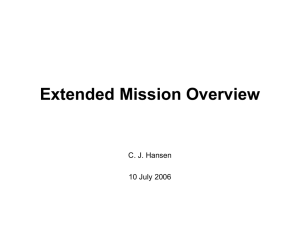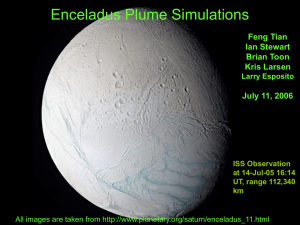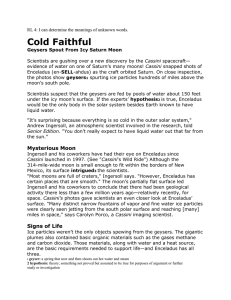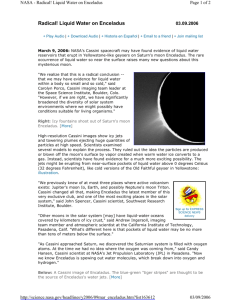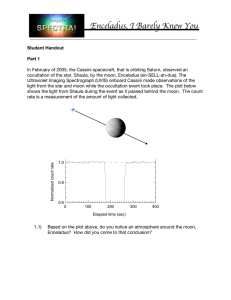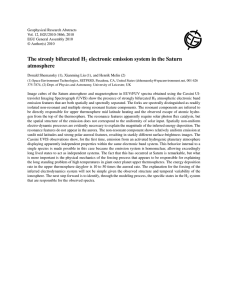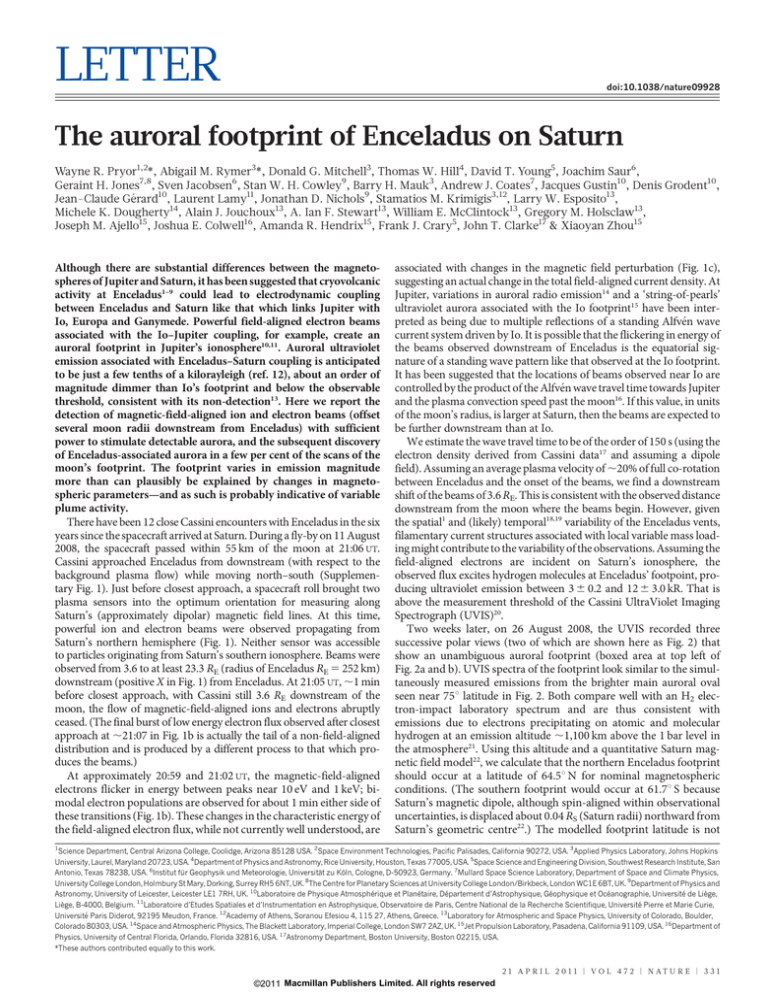
LETTER
doi:10.1038/nature09928
The auroral footprint of Enceladus on Saturn
Wayne R. Pryor1,2*, Abigail M. Rymer3*, Donald G. Mitchell3, Thomas W. Hill4, David T. Young5, Joachim Saur6,
Geraint H. Jones7,8, Sven Jacobsen6, Stan W. H. Cowley9, Barry H. Mauk3, Andrew J. Coates7, Jacques Gustin10, Denis Grodent10,
Jean-Claude Gérard10, Laurent Lamy11, Jonathan D. Nichols9, Stamatios M. Krimigis3,12, Larry W. Esposito13,
Michele K. Dougherty14, Alain J. Jouchoux13, A. Ian F. Stewart13, William E. McClintock13, Gregory M. Holsclaw13,
Joseph M. Ajello15, Joshua E. Colwell16, Amanda R. Hendrix15, Frank J. Crary5, John T. Clarke17 & Xiaoyan Zhou15
Although there are substantial differences between the magnetospheres of Jupiter and Saturn, it has been suggested that cryovolcanic
activity at Enceladus1–9 could lead to electrodynamic coupling
between Enceladus and Saturn like that which links Jupiter with
Io, Europa and Ganymede. Powerful field-aligned electron beams
associated with the Io–Jupiter coupling, for example, create an
auroral footprint in Jupiter’s ionosphere10,11. Auroral ultraviolet
emission associated with Enceladus–Saturn coupling is anticipated
to be just a few tenths of a kilorayleigh (ref. 12), about an order of
magnitude dimmer than Io’s footprint and below the observable
threshold, consistent with its non-detection13. Here we report the
detection of magnetic-field-aligned ion and electron beams (offset
several moon radii downstream from Enceladus) with sufficient
power to stimulate detectable aurora, and the subsequent discovery
of Enceladus-associated aurora in a few per cent of the scans of the
moon’s footprint. The footprint varies in emission magnitude
more than can plausibly be explained by changes in magnetospheric parameters—and as such is probably indicative of variable
plume activity.
There have been 12 close Cassini encounters with Enceladus in the six
years since the spacecraft arrived at Saturn. During a fly-by on 11 August
2008, the spacecraft passed within 55 km of the moon at 21:06 UT.
Cassini approached Enceladus from downstream (with respect to the
background plasma flow) while moving north–south (Supplementary Fig. 1). Just before closest approach, a spacecraft roll brought two
plasma sensors into the optimum orientation for measuring along
Saturn’s (approximately dipolar) magnetic field lines. At this time,
powerful ion and electron beams were observed propagating from
Saturn’s northern hemisphere (Fig. 1). Neither sensor was accessible
to particles originating from Saturn’s southern ionosphere. Beams were
observed from 3.6 to at least 23.3 RE (radius of Enceladus RE 5 252 km)
downstream (positive X in Fig. 1) from Enceladus. At 21:05 UT, ,1 min
before closest approach, with Cassini still 3.6 RE downstream of the
moon, the flow of magnetic-field-aligned ions and electrons abruptly
ceased. (The final burst of low energy electron flux observed after closest
approach at ,21:07 in Fig. 1b is actually the tail of a non-field-aligned
distribution and is produced by a different process to that which produces the beams.)
At approximately 20:59 and 21:02 UT, the magnetic-field-aligned
electrons flicker in energy between peaks near 10 eV and 1 keV; bimodal electron populations are observed for about 1 min either side of
these transitions (Fig. 1b). These changes in the characteristic energy of
the field-aligned electron flux, while not currently well understood, are
associated with changes in the magnetic field perturbation (Fig. 1c),
suggesting an actual change in the total field-aligned current density. At
Jupiter, variations in auroral radio emission14 and a ‘string-of-pearls’
ultraviolet aurora associated with the Io footprint15 have been interpreted as being due to multiple reflections of a standing Alfvén wave
current system driven by Io. It is possible that the flickering in energy of
the beams observed downstream of Enceladus is the equatorial signature of a standing wave pattern like that observed at the Io footprint.
It has been suggested that the locations of beams observed near Io are
controlled by the product of the Alfvén wave travel time towards Jupiter
and the plasma convection speed past the moon16. If this value, in units
of the moon’s radius, is larger at Saturn, then the beams are expected to
be further downstream than at Io.
We estimate the wave travel time to be of the order of 150 s (using the
electron density derived from Cassini data17 and assuming a dipole
field). Assuming an average plasma velocity of ,20% of full co-rotation
between Enceladus and the onset of the beams, we find a downstream
shift of the beams of 3.6 RE. This is consistent with the observed distance
downstream from the moon where the beams begin. However, given
the spatial1 and (likely) temporal18,19 variability of the Enceladus vents,
filamentary current structures associated with local variable mass loading might contribute to the variability of the observations. Assuming the
field-aligned electrons are incident on Saturn’s ionosphere, the
observed flux excites hydrogen molecules at Enceladus’ footpoint, producing ultraviolet emission between 3 6 0.2 and 12 6 3.0 kR. That is
above the measurement threshold of the Cassini UltraViolet Imaging
Spectrograph (UVIS)20.
Two weeks later, on 26 August 2008, the UVIS recorded three
successive polar views (two of which are shown here as Fig. 2) that
show an unambiguous auroral footprint (boxed area at top left of
Fig. 2a and b). UVIS spectra of the footprint look similar to the simultaneously measured emissions from the brighter main auroral oval
seen near 75u latitude in Fig. 2. Both compare well with an H2 electron-impact laboratory spectrum and are thus consistent with
emissions due to electrons precipitating on atomic and molecular
hydrogen at an emission altitude ,1,100 km above the 1 bar level in
the atmosphere21. Using this altitude and a quantitative Saturn magnetic field model22, we calculate that the northern Enceladus footprint
should occur at a latitude of 64.5u N for nominal magnetospheric
conditions. (The southern footprint would occur at 61.7u S because
Saturn’s magnetic dipole, although spin-aligned within observational
uncertainties, is displaced about 0.04 RS (Saturn radii) northward from
Saturn’s geometric centre22.) The modelled footprint latitude is not
1
Science Department, Central Arizona College, Coolidge, Arizona 85128 USA. 2Space Environment Technologies, Pacific Palisades, California 90272, USA. 3Applied Physics Laboratory, Johns Hopkins
University, Laurel, Maryland 20723, USA. 4Department of Physics and Astronomy, Rice University, Houston, Texas 77005, USA. 5Space Science and Engineering Division, Southwest Research Institute, San
Antonio, Texas 78238, USA. 6Institut für Geophysik und Meteorologie, Universität zu Köln, Cologne, D-50923, Germany. 7Mullard Space Science Laboratory, Department of Space and Climate Physics,
University College London, Holmbury St Mary, Dorking, Surrey RH5 6NT, UK. 8The Centre for Planetary Sciences at University College London/Birkbeck, London WC1E 6BT, UK. 9Department of Physics and
Astronomy, University of Leicester, Leicester LE1 7RH, UK. 10Laboratoire de Physique Atmosphérique et Planétaire, Département d’Astrophysique, Géophysique et Océanographie, Université de Liège,
Liège, B-4000, Belgium. 11Laboratoire d’Etudes Spatiales et d’Instrumentation en Astrophysique, Observatoire de Paris, Centre National de la Recherche Scientifique, Université Pierre et Marie Curie,
Université Paris Diderot, 92195 Meudon, France. 12Academy of Athens, Soranou Efesiou 4, 115 27, Athens, Greece. 13Laboratory for Atmospheric and Space Physics, University of Colorado, Boulder,
Colorado 80303, USA. 14Space and Atmospheric Physics, The Blackett Laboratory, Imperial College, London SW7 2AZ, UK. 15Jet Propulsion Laboratory, Pasadena, California 91109, USA. 16Department of
Physics, University of Central Florida, Orlando, Florida 32816, USA. 17Astronomy Department, Boston University, Boston 02215, USA.
*These authors contributed equally to this work.
2 1 A P R I L 2 0 1 1 | VO L 4 7 2 | N AT U R E | 3 3 1
©2011 Macmillan Publishers Limited. All rights reserved
RESEARCH LETTER
20:57:30
21:00
21:02:30
21:05
21:07:30
20
55–90 keV
INCA
ion flux
20:55
10
0
Datagap
ELS electrons
log(energy (keV))
–1
30
20
–2
10
20
2.0
10
1.0
0
0.0
Anti-draped ΔB
Draped ΔB
Upward FAE flux
–10
Time (UT)
X (REnc)
Y (REnc)
Z (REnc)
20:55
23.3
–2.0
41.7
–1.0
1011
1010
109
+Z North
21:10
+Y
+X
–6.2
Along
0.8 Toward
–14.3 Saturn co-rotation
21:05
3.6
–0.4
4.3
21:00
13.4
–1.4
23.0
1012
Upward electron
flux (mW m–2)
Azimuthal B-field
perturbation (nT)
0
Closest
approach
Pitch angle (°)
c
1
DEF (s–1 m–2 sr–1)
b
Proton diff. flux
(cm–2 sr–1
s–1 keV–1)
20:52:30
a
Figure 1 | Cassini particle and field observations on 11 August 2008.
a, Protons (55–90 keV) observed by the Cassini Ion and Neutral Camera
(INCA)26. Colours indicate proton differential flux. Contours 30u and 60u from
the magnetic field direction are overplotted in white. b, Electrons (1 eV to
22 keV) measured by the most field-aligned detectors of the CAPS Electron
Spectrometer (ELS)27. Electron differential energy flux (DEF) is indicated by the
colour bar. Field-aligned electrons are observed when the instrument measured
within ,20u of the magnetic field line, as indicated by the white line (pitch
angle). The blacked out regions are data gaps. c, Azimuthal perturbation (DB)
in the magnetic field during this interval, calculated by subtracting a model
background field from the total field measured by the Cassini magnetometer
(MAG)28,29. Positive DB (red) is in the direction of co-rotation; the signature
expected from simple field line draping around an obstacle is characterized by
negative DB (blue) above the equator. Positive DB (red) indicates an antidraped perturbation in the super-co-rotational sense. Overplotted in green is
the total upward field-aligned electron (FAE) energy flux derived by numerical
integration of the electron data in b (see Supplementary Information for
additional discussion and error analysis). Calculations of electron energy loss in
H2 atmospheres indicate that 1 mW m22 of particle energy input produces
,10 kR of auroral ultraviolet emission30. The observed electron energy flux is
therefore expected to produce a ultraviolet emission brightness between
2.8 6 0.2 and 11.9 6 3.0 kR.
very sensitive to auroral altitude; it would shift only 0.04u equatorward
if the assumed auroral altitude were increased to 1,200 km. It is also not
very sensitive to the size of the magnetospheric cavity, varying by only
,0.1u over the whole range of sizes observed during the 6-year Cassini
mission.
The location of the observed northern footprint is consistent with
the expected location. The brightness centroid of the first spot (Fig. 2a)
was at latitude 64.1u 6 0.4u and longitude 286.0u 6 0.5u, thus about
1.7u downstream of the sub-Enceladus longitude of 287.7u. Here we
have set errors equal to the pixel size. The brightness centroid of the
b
a
1
2
5
10 20
50 100 200
EUV counts per pixel
500 1,000
Figure 2 | Cassini images of Saturn’s northern aurora, including the
Enceladus auroral footprint. a, b, Successive UVIS EUV polar-projected
images of Saturn’s north polar region from 26 August 2008 (day of year 239);
02:16–03:28 UT (a) and 03:38–04:50 UT (b). Images were formed by slowly
slewing the spacecraft and its long-slit ultraviolet spectrometer. During this
interval, Cassini moved from sub-spacecraft latitudes of 74u N to 65u N, and
from 8.1 to 6.0 RS (Saturn radius RS < 60,300 km) from Saturn’s centre. Each
1
2
5
10 20
50 100 200
EUV counts per pixel
500 1,000
image represents two spacecraft slews across the planet. The colour bar shows
EUV emission per pixel. The white boxes are centred on 64.5u N and the subEnceladus longitude, cover 4u in latitude and 10u in longitude, and enclose the
predicted magnetic mapping of the satellite Enceladus to Saturn’s dayside
atmosphere. Satellite footprint emission is visible in both boxes. The north pole
is at the centre; the latitude circles are 5u apart, and the hashed white line
indicates the day/night terminator. The Sun is to the left.
3 3 2 | N AT U R E | VO L 4 7 2 | 2 1 A P R I L 2 0 1 1
©2011 Macmillan Publishers Limited. All rights reserved
LETTER RESEARCH
second spot was at latitude 64.3u 6 0.3u and longitude 316.8u 6 0.4u,
about 0.8u downstream of the sub-Enceladus longitude of 317.6u.
These values are very close to the anticipated Enceladus footprint
latitude of 64.5u. This agreement confirms both the identification with
Enceladus and the accuracy of the magnetic field model, a ‘groundtruth’ observation which proved vital in confirming the detailed magnetic field configuration of Jupiter23 and is equally valuable at Saturn.
The predicted southern footprint has not yet been detected (28 of the
310 non-detections were of the southern ionosphere); the southern
footprint may be dimmer than its northern counterpart, as is the case
for the main aurora24.
The 504 km diameter of Enceladus maps along Saturn’s magnetic
field lines to a quasi-elliptical spot ,52 3 29 km in Saturn’s atmosphere, for average magnetospheric conditions. This spot would be
spatially unresolved by UVIS. For a steady fixed source, the UVIS
observations suggest emission connected to an Enceladus interaction
region at the equator extending as far as 20 RE downstream with a
radial extent between 0 and 20 RE, consistent with the location of the
beams observed at the equator.
The slewing UVIS slit passed over and recorded the Enceladusrelated spot on 26 August 2008 at 3:00, at 4:20 and at 8:02 UT. The
spot dims as it moves from near dawn towards noon (8:20 to 9:12 to
11:54 local time). The total combined (extreme ultraviolet (EUV) plus
far ultraviolet (FUV)) spot brightnesses in the three UVIS images were
1,550 6 340 R, 1,130 6 200 R and 450 6 290 R. These should be considered lower limits, assuming the spatial pixel is uniformly filled by
signal, because the true emission region size is not known (see Supplementary Information for more details). Thus (even when visible)
the Enceladus auroral footprint varies in brightness by a factor of about
3. At Jupiter, footprint emission variability is principally caused by the
rocking of the magnetospheric plasma sheet, as the magnetic dipole
moment is inclined with respect to the spin axis. At Saturn, there is no
substantial rocking of the plasma sheet at the location of Enceladus,
but we still see these large brightness variations. This variation could,
in principle, reflect variations of plume activity18,19, of ionization rates
(owing to varying background plasma conditions), or of magnetospheric size (when the magnetosphere is compressed, auroral emissions are generally enhanced). The last two factors do not typically
exhibit order-of-magnitude variations17,25. The most likely cause for
the observed large-scale variability, therefore, is time-variable cryovolcanism from Enceladus’ south polar vents, suggesting that plume
activity was particularly high during August 2008. Thus, systematic
monitoring of Enceladus’ ultraviolet auroral footprint might provide
evidence of plume variability, which is an important open issue.
Received 13 July 2010; accepted 10 February 2011.
1.
2.
3.
4.
5.
6.
7.
8.
9.
Porco, C. C. et al. Cassini observes the active south pole of Enceladus. Science 311,
1393–1401 (2006).
Spencer, J. R. et al. Cassini encounters Enceladus: background and the discovery
of a south polar hot spot. Science 311, 1401–1405 (2006).
Dougherty, M. K. et al. Identification of a dynamic atmosphere at Enceladus with
the Cassini magnetometer. Science 311, 1406–1409 (2006).
Tokar, R. L. et al. The interaction of the atmosphere of Enceladus with Saturn’s
plasma. Science 311, 1409–1412 (2006).
Jones, G. H. et al. Enceladus’ varying imprint on the magnetosphere of Saturn.
Science 311, 1412–1415 (2006).
Spahn, F. et al. Cassini dust measurements at Enceladus and implications for the
origin of the E ring. Science 311, 1416–1418 (2006).
Waite, J. H. et al. Cassini ion and neutral mass spectrometer: Enceladus plume
composition and structure. Science 311, 1419–1422 (2006).
Hansen, C. J. et al. Enceladus’ water vapor plume. Science 311, 1422–1425
(2006).
Brown, R. H. et al. Composition and physical properties of Enceladus’ surface.
Science 311, 1425–1428 (2006).
10. Connerney, J. E. P., Baron, R., Satoh, T. & Owen, T. Images of excited H31 at the foot
of the Io flux tube in Jupiter’s atmosphere. Science 262, 1035–1038 (1993).
11. Clarke, J. T. et al. Ultraviolet emissions from the magnetic footprints of Io,
Ganymede, and Europa on Jupiter. Nature 415, 997–1000 (2002).
12. Pontius, D. H. Jr & Hill, T. W. Enceladus: a significant plasma source for Saturn’s
magnetosphere. J. Geophys. Res. 111, A09214, doi:10.1029/2006JA011674
(2006).
13. Wannawichian, S., Clarke, J. T. & Pontius, D. H. Jr. Interaction evidence between
Enceladus’ atmosphere and Saturn’s magnetosphere. J. Geophys. Res. 113,
A07217, doi:10.1029/2007JA012899 (2008).
14. Gurnett, D. A. & Goertz, C. K. Multiple Alfven wave reflections excited by Io, origin of
the Jovian decametric arcs. J. Geophys. Res. 86 (A2), 717–722 (1981).
15. Bonfond, B. et al. UV Io footprint leading spot: a key feature for understanding the
UV Io footprint multiplicity? Geophys. Res. Lett. 35, L05107, doi:10.1029/
2007GL032418 (2008).
16. Jacobsen, S. J. et al. Location and spatial shape of electron beams in Io’s wake. J.
Geophys. Res. 115, A04205, doi:10.1029/2009JA014753 (2010).
17. Persoon, A. M., Gurnett, D. A., Kurth, W. S. & Groene, J. B. A simple scale height
model of the electron density in Saturn’s plasma disk. Geophys. Res. Lett. 33,
L18106, doi:10.1029/2006GL027090 (2006).
18. Saur, J. et al. Evidence for temporal variability of Enceladus’ gas jets: modeling of
Cassini observations. Geophys. Res. Lett. 35, L20105, doi:10.1029/
2008GL035811 (2008).
19. Smith, H. T. et al. Enceladus plume variability and the neutral gas densities in
Saturn’s magnetosphere. J. Geophys. Res. 115, A10252, doi:10.1029/
2009JA015184 (2010).
20. Esposito, L. W. et al. the Cassini ultraviolet imaging spectrograph investigation.
Space Sci. Rev. 115, 299–361 (2004).
21. Gérard, J.-C. et al. Altitude of Saturn’s aurora and its implications for the
characteristic energy of precipitated electrons. Geophys. Res. Lett. 36, L02202,
doi:10.1029/2008GL036554 (2009).
22. Burton, M. E., Dougherty, M. K. & Russell, C. T. Model of Saturn’s internal planetary
magnetic field based on Cassini observations. Planet. Space Sci. 57, 1706–1713
(2009).
23. Connerney, J. E. P., Acuñna, M. H., Ness, N. F. & Satoh, T. New models of Jupiter’s
magnetic field constrained by the Io flux tube footprint. J. Geophys. Res. 103,
11929–11939 (1998).
24. Nichols, J. D. et al. Saturn’s equinoctial auroras. Geophys. Res. Lett. 36, L24102,
doi:10.1029/2009GL041491 (2009).
25. Kanani, S. J. et al. A new form of Saturn’s magnetopause using a dynamic pressure
balance model, based on in situ, multi-instrument Cassini measurements. J.
Geophys. Res. 115, A06207, doi:10.1029/2009JA014262 (2010).
26. Krimigis, S. M. et al. Magnetospheric imaging instrument (MIMI) on the Cassini
mission to Saturn/Titan. Space Sci. Rev. 114, 233–329 (2004).
27. Young, D. T. et al. Cassini plasma spectrometer investigation. Space Sci. Rev. 114,
1–112 (2004).
28. Dougherty, M. K. et al. The Cassini magnetic field investigation. Space Sci. Rev. 114,
331–383 (2004).
29. Jia, Y.-D. et al. Time varying magnetospheric environment near Enceladus as seen
by the Cassini magnetometer. Geophys. Res. Lett. 37, L09203, doi:10.1029/
2010GL042948 (2010).
30. Waite, J. Jr et al. Electron precipitation and related aeronomy of the Jovian
thermosphere and ionosphere. J. Geophys. Res. 88, 6143–6163 (1983).
Supplementary Information is linked to the online version of the paper at
www.nature.com/nature.
Acknowledgements We acknowledge support from the NASA/ESA Cassini Project and
NASA’s Cassini Data Analysis Program.
Author Contributions A.M.R. and W.R.P. discovered the electron beams and the auroral
footprint, respectively, and wrote most of the paper. D.G.M. discovered the ion beams
and contributed to the text and interpretation. T.W.H. contributed extensively to the text
and interpretation. D.T.Y. is CAPS PI and contributed extensively to the text and
interpretation. J.S., G.H.J., S.J., B.H.M. and A.J.C. advised on the interpretation of the in
situ data. S.W.H.C. performed the field line mapping and provided advice on the paper.
J.G., D.G., J.-C.G., L.L. and J.D.N. advised on the interpretation of the UVIS data. S.M.K. is
the MIMI PI and oversaw the ion data. M.K.D. is the MAG PI and oversaw the
magnetometer data. L.W.E. is the UVIS PI and oversaw the UVIS data. A.J.J. and F.J.C.
designed the auroral observation campaign. A.I.F.S., W.E.M., J.M.A., J.E.C. and A.R.H.
helped to process the UVIS data. J.T.C. provided advice on the HST observations. X.Z.
contributed to auroral discussions related to comparisons with terrestrial auroral
processes.
Author Information Reprints and permissions information is available at
www.nature.com/reprints. The authors declare no competing financial interests.
Readers are welcome to comment on the online version of this article at
www.nature.com/nature. Correspondence and requests for materials should be
addressed to A.M.R. (abigail.rymer@jhuapl.edu).
2 1 A P R I L 2 0 1 1 | VO L 4 7 2 | N AT U R E | 3 3 3
©2011 Macmillan Publishers Limited. All rights reserved

